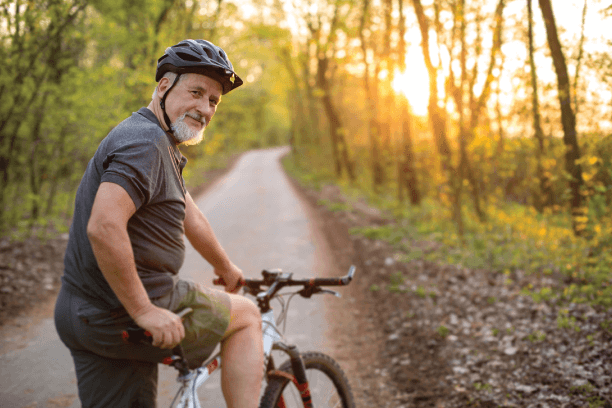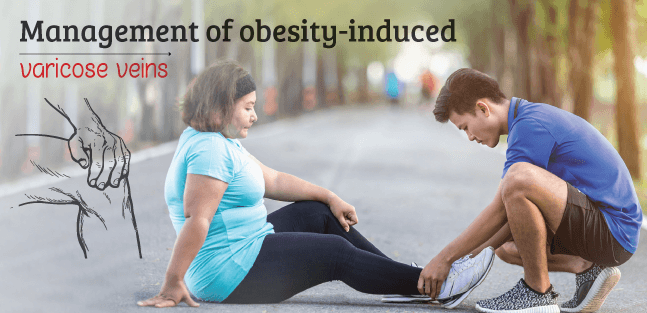Disease, Health, Weight Loss
How Does Obesity Lead To Varicose Veins & How Should You Deal With It?
One major causative factor when it comes to varicose veins is obesity. While there are many factors contributing to varicose veins such as vein injuries, age, gender, and family history, obesity is a major risk factor.
Speculated that around 30% of individuals develop some or the other form of varicose veins at some point in their lives.
Read on to know why obesity is a risk factor for varicose veins, as well as the symptoms of varicose veins and the best treatment for the same.
Table Of Contents
- Varicose veins definition
- Obesity and varicose veins
- What causes varicose veins?
- Varicose veins symptoms
- Varicose veins treatment
Did you know India has a high obesity rate? Find out why.
Varicose veins definition
Also known as varicosities or varicoses, varicose veins occur when the veins become overfilled with blood, dilated, and enlarged.
Typically, the veins appear raised and swollen and are red or bluish-purple in color. More often than not, they are painful and occur especially in women.
Obesity and varicose veins
It is undoubtedly the biggest cause of varicose veins, but how does it cause varicose veins? Obesity puts extra pressure on the veins of the legs, making it harder for their valve to pump blood back to the heart against gravity. These valves play an important role in preventing the blood from flowing backward and coagulating in the legs.
Did you know?
According to a Huffington Post report, it is more difficult to assess and diagnose varicose veins for overweight and obese people. Its because the signs and symptoms go unnoticed until they have worsened.
Over time, the valves could fail due to the extra body weight, resulting in a back-pressure which could cause the vein branches to expand and become varicose veins.
Other risk factors related to obesity, such as lack of physical activity and high blood pressure, are risk factors for varicose veins as well.
Click here to know the top obesity-related diseases.
Did you know?
According to 2018 study of The Journal of the American Medical Association, individuals with varicose veins stand a 5x risk of developing deep-vein thrombosis (DVT).
The study of 2,00,000+ varicose veins patients with an average age of 54.5 years compared with 2,00,000+ non-varicose veins patients with an average age of 54.3 years was conducted over 13 years, with a 7-year follow up. It showed that patients with varicose veins often suffered from DVT.
What causes varicose veins?
When the veins in the leg do not function properly it causes varicose veins. There are several causes of varicose veins, which include:
- Any family history of varicose veins
- Obesity
- Standing for long periods of time
- If your age is more than 50 years
- Menopause
- Pregnancy
Here are some yoga poses for easy delivery and weight maintenance during pregnancy.
Varicose veins symptoms
You have varicose veins pain may or may not occur, its signs are palpable when you see varicose veins in person or varicose veins pictures. They include:
- Blue-purple or red veins
- Bulging and twisted veins
- A heavy, achy feeling in the legs
- Swelling, muscle cramping, throbbing and burning in the lower legs
- Worsened pain after standing or sitting for a long time
- Bleeding from the veins
- Itching around the veins
If you have skin ulcers near the ankle or see skin inflammation, or hardening of the veins, or any color changes, then you have a serious form of varicose veins and should consult the doctor immediately.
Did you know?
According to The Journal of the American Medical Association’s 2012 report, treatments for varicose veins range from conservative (lifestyle changes, meds), to minimally invasive (sclerotherapy), to invasive (surgery), and finally hybrid (combining two or more therapies).
Varicose veins treatment
For solving any health issue, knowing your BMI is a must. Find your BMI with TruWeight.
Luckily, varicose veins treatments neither mean a hospital stay nor a painful, long recovery. Listed below are the easiest, best treatments for varicose veins:
1.Compression stockings:
The most common ways to treat varicose veins is to wear compression stockings all day. They squeeze your legs steadily and help the leg muscles and veins circulate blood more efficiently.
2. Exercise:
One of the best preventive measure for varicose veins is to get moving – literally. Regular exercise will lower inflammation and improve blood flow.
Try not to stand or sit for a long time without moving around, as staying stagnant in one position for long makes it harder for your veins to fight gravity to pump blood efficiently back to the heart.
Exercise also helps lower blood pressure, maintain healthy body weight, lose weight and balances hormones naturally, all of which contribute to varicose veins.
Indulge in low impact exercises such as cycling, swimming, and walking, as well as side lunges, bicycle legs, calf raises, and leg lifts to stretch and strengthen the veins and alleviate the pressure.
 TruWeight suggests some great exercises to tone your lower half of the body.
TruWeight suggests some great exercises to tone your lower half of the body.
3. Diet:
A poor diet with processed foods, alcohol, caffeine, sugar and trans fats is a strict no-no for those with varicose veins, as they contribute to weight gain, hormonal imbalance, blood pressure, low blood circulation, and arterial damage.
However, there are also foods which help improve blood flow and reverse inflammation, making varicose veins heal quicker.
These include oily and wild-caught fish, spicy foods, apple cider vinegar, high-antioxidant and high-fiber foods, magnesium-rich foods, and natural diuretics.
If you have high blood pressure, this diet is for you.
In the end, it is thorough self-care — avoiding long sitting or standing periods, elevating legs, not wearing tight clothes, losing weight and exercising – which can prevent the worsening of varicose veins.
FAQs
Q. What causes varicose veins?
When the walls of the vein become less flexible or elastic or stretched, then one-way valves in the veins get weaker. Weakened valves cause blood to coagulate, leak backward, and possibly flow in the opposite direction, enlarging the veins.
Q. When is varicose veins surgery needed?
Doctors might suggest surgical treatment of varicose veins if the condition is severe, the lifestyle changes aren’t working, if the compression stockings and self-care doesn’t work, or if the varicose veins are painful and damaging your health.
Q.What are the preventive measures for varicose veins?
Exercising, losing weight, not wearing tight clothes, elevating legs, avoiding long sitting or standing periods, a good diet, and wearing compression stockings are the best ways to prevent varicose veins.
Talk to our expert Possible Nutritionist for more information and guidance. The first consultation is on us. Click here to avail.

it a great post , here is the a free e-book about How to lose weight fast ! safe and effective weight loss -weight loss tips – how to lose belly fat
https://www.slideshare.net/healthandfitness8785/how-to-lose-weight-fast-safe-and-effective-weight-loss-weight-loss-tips-how-to-lose-belly-fat